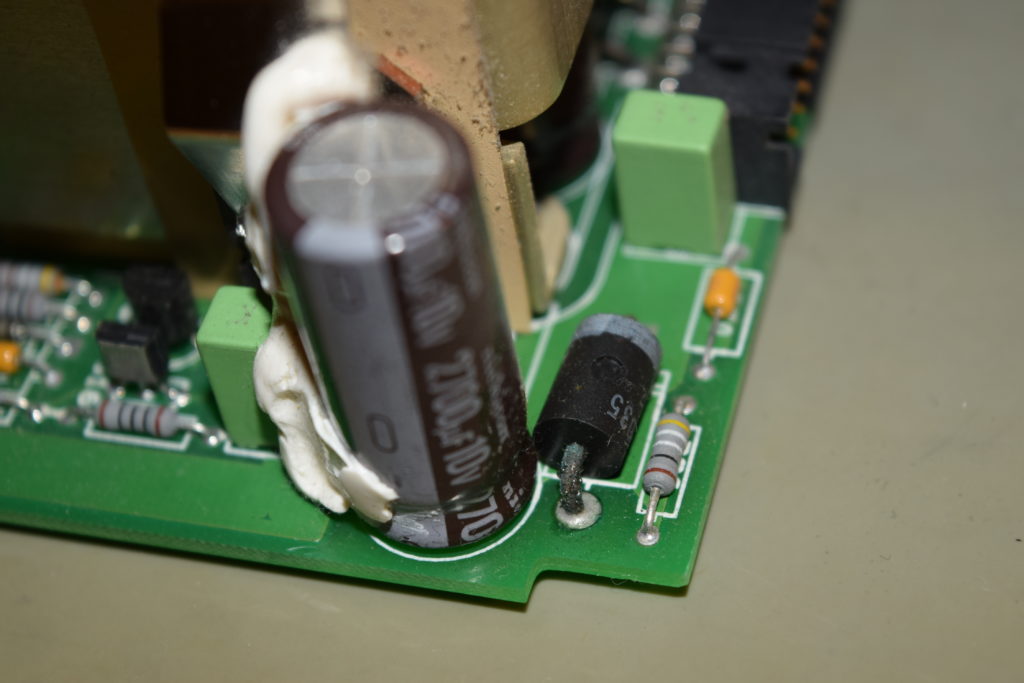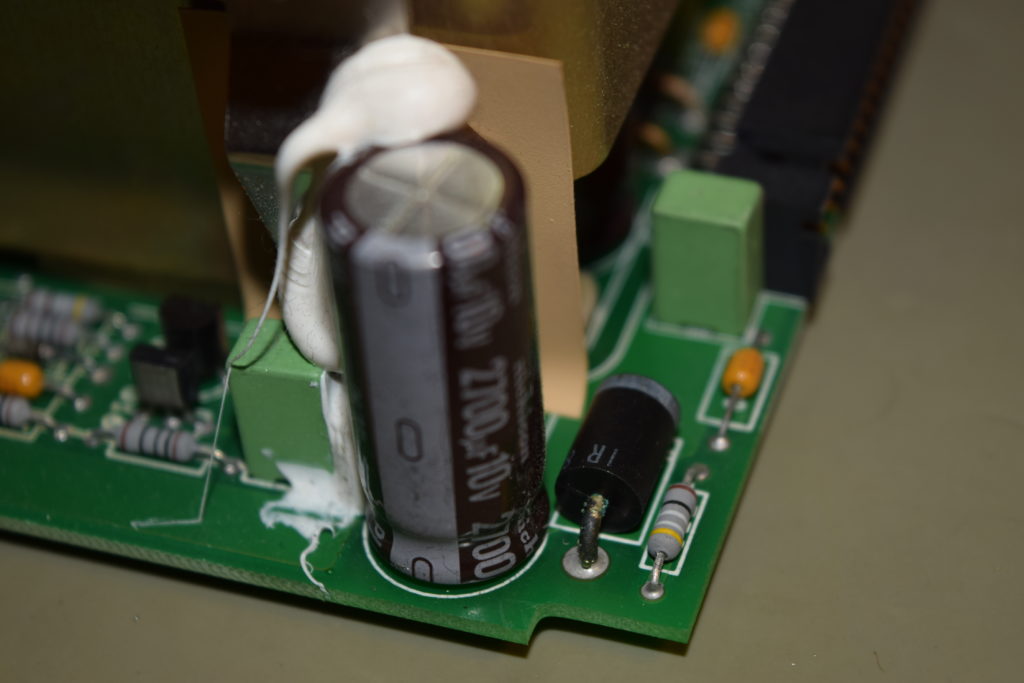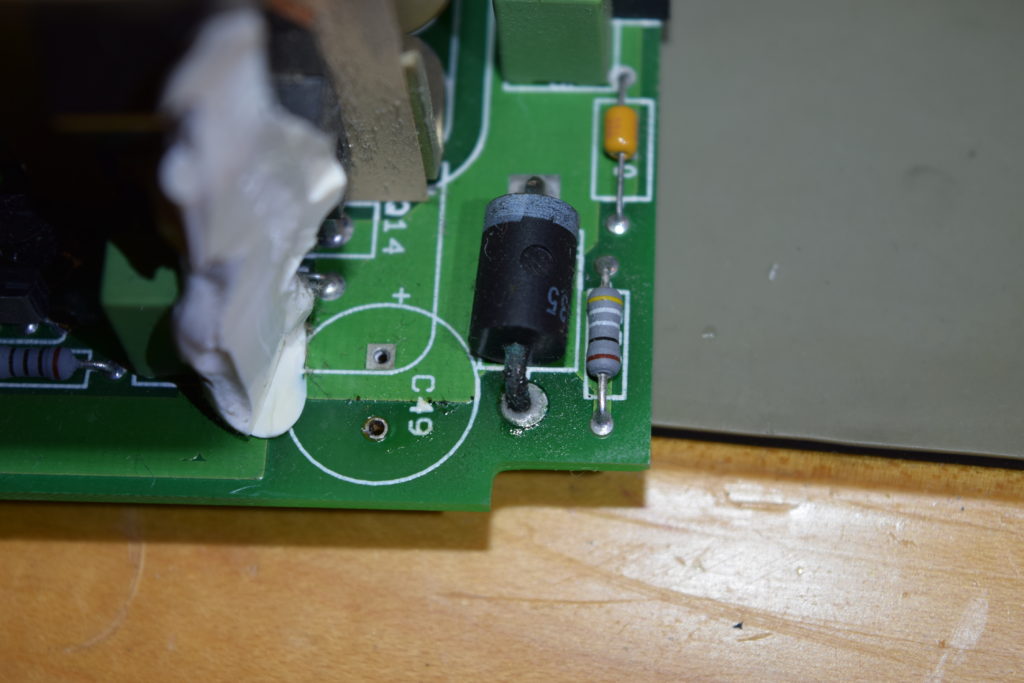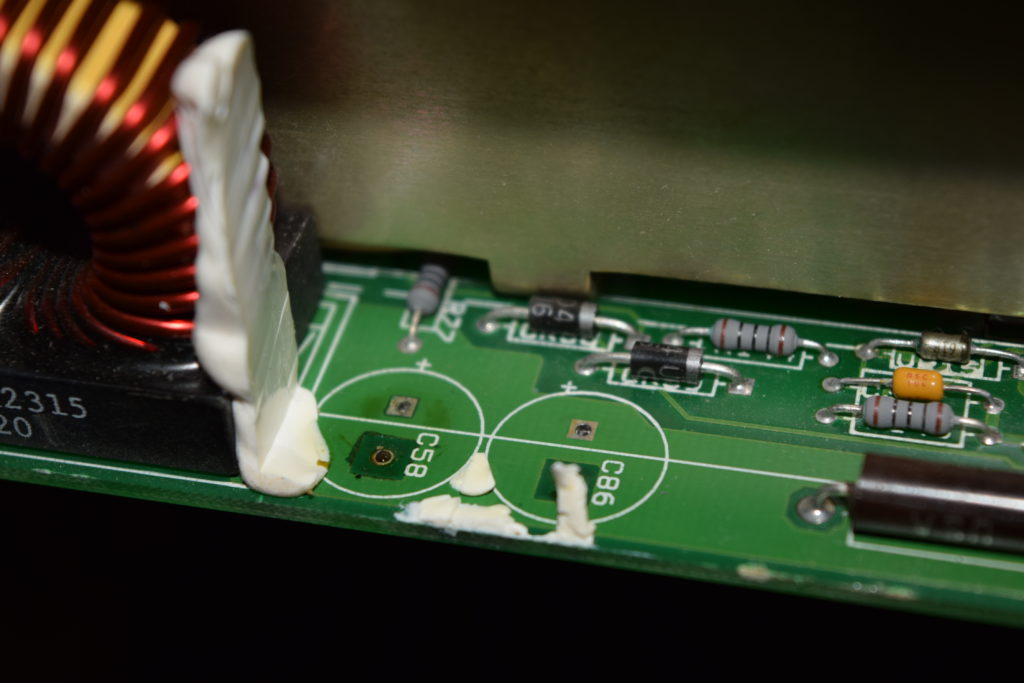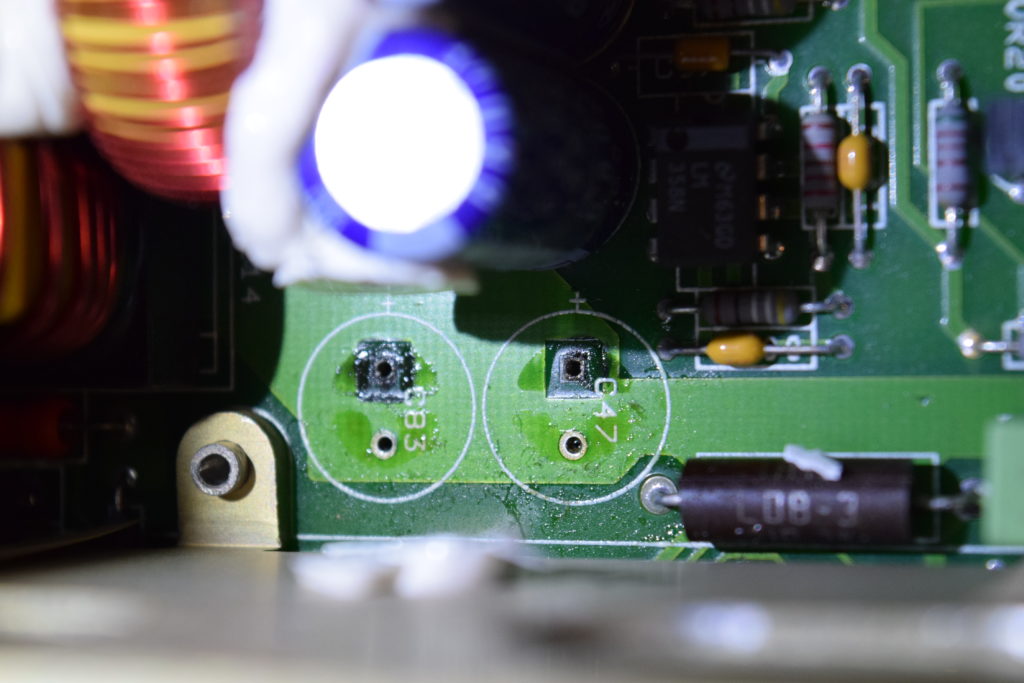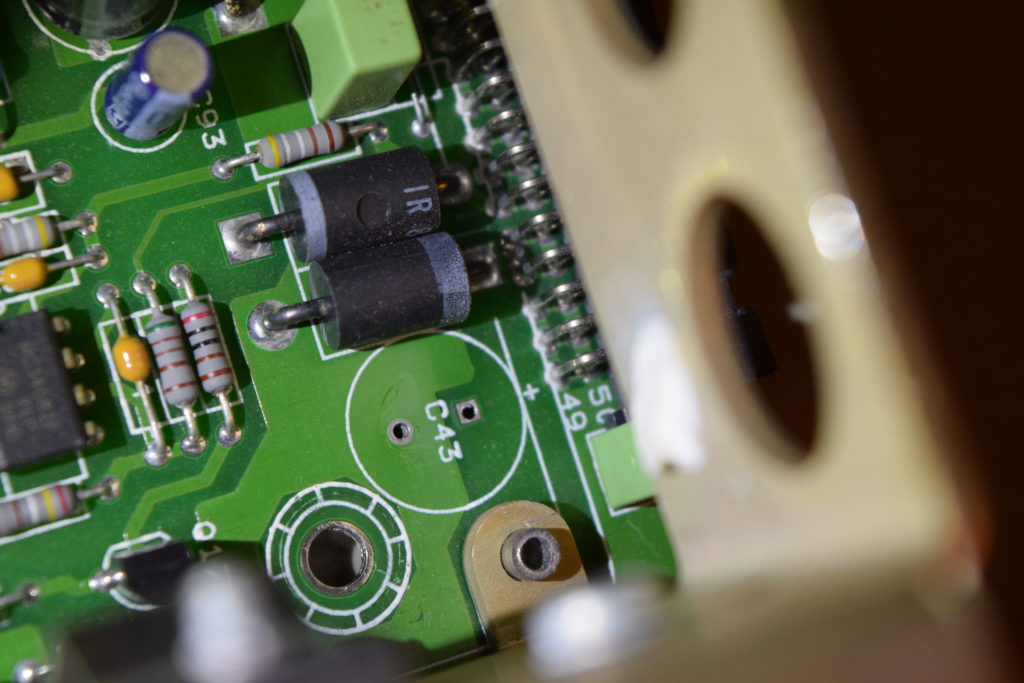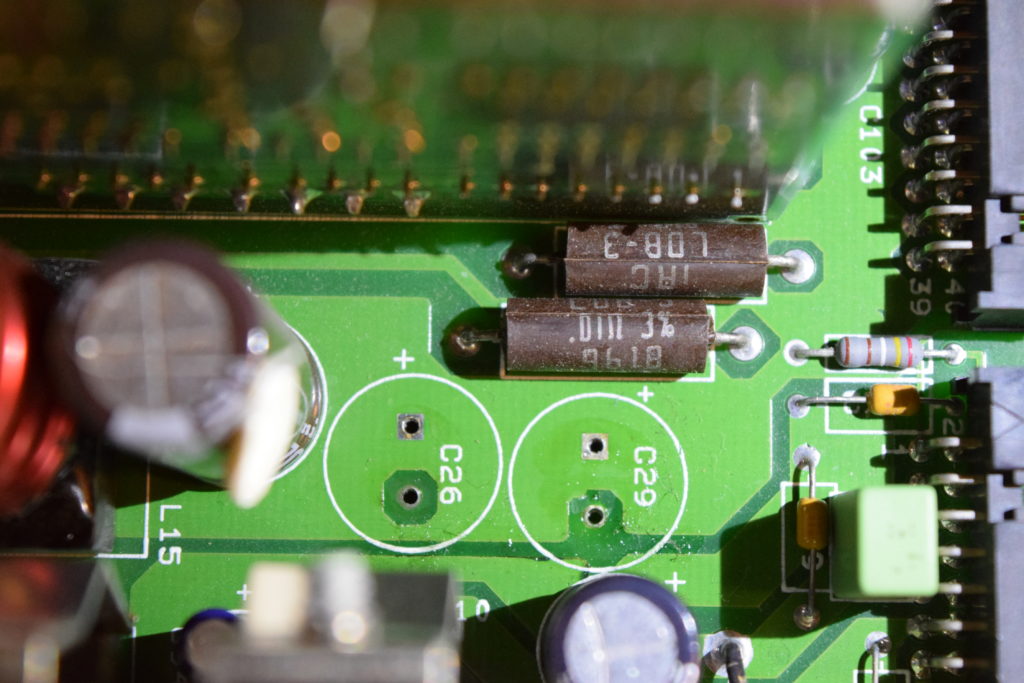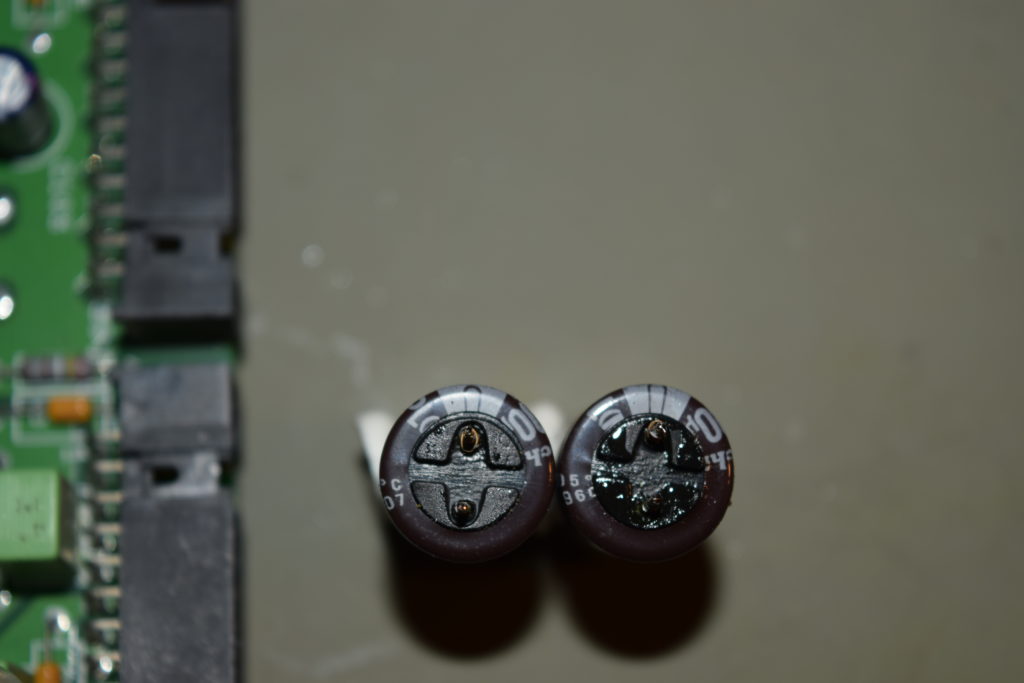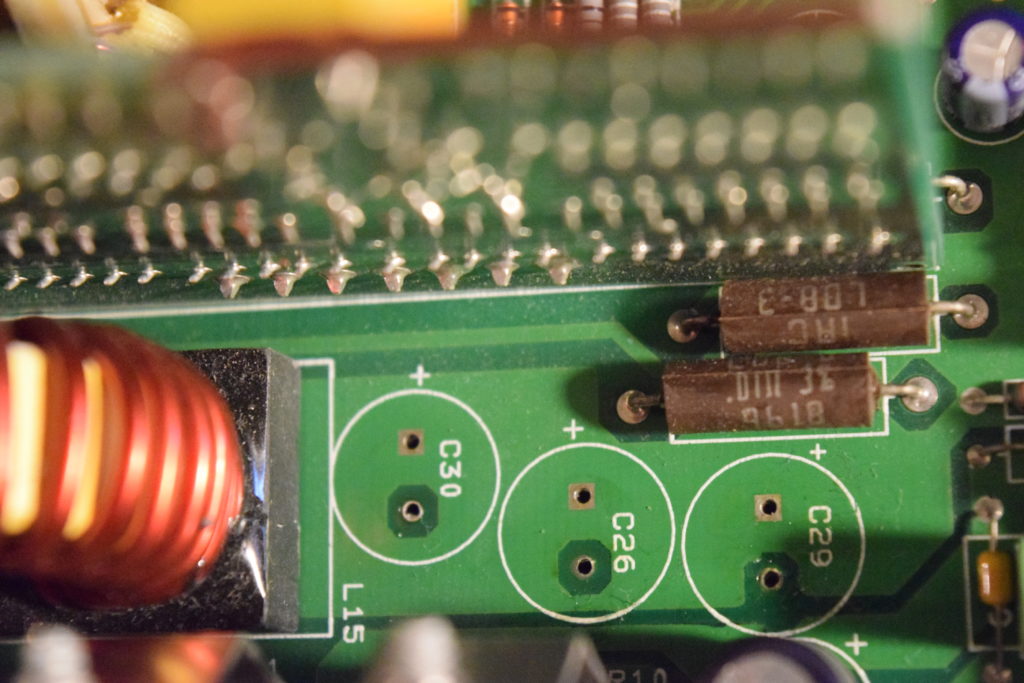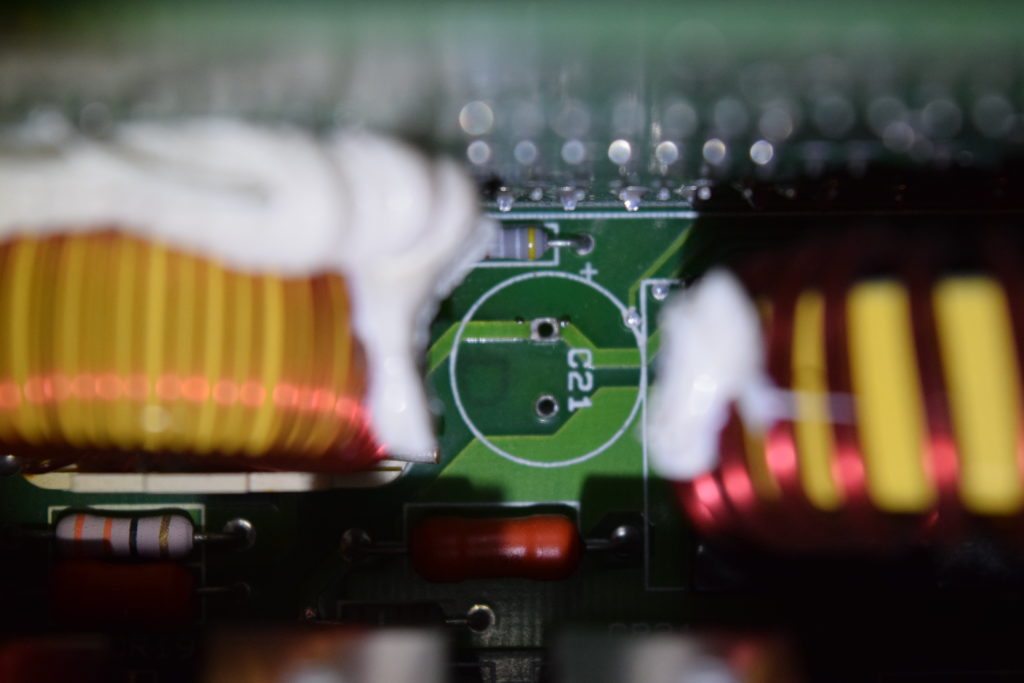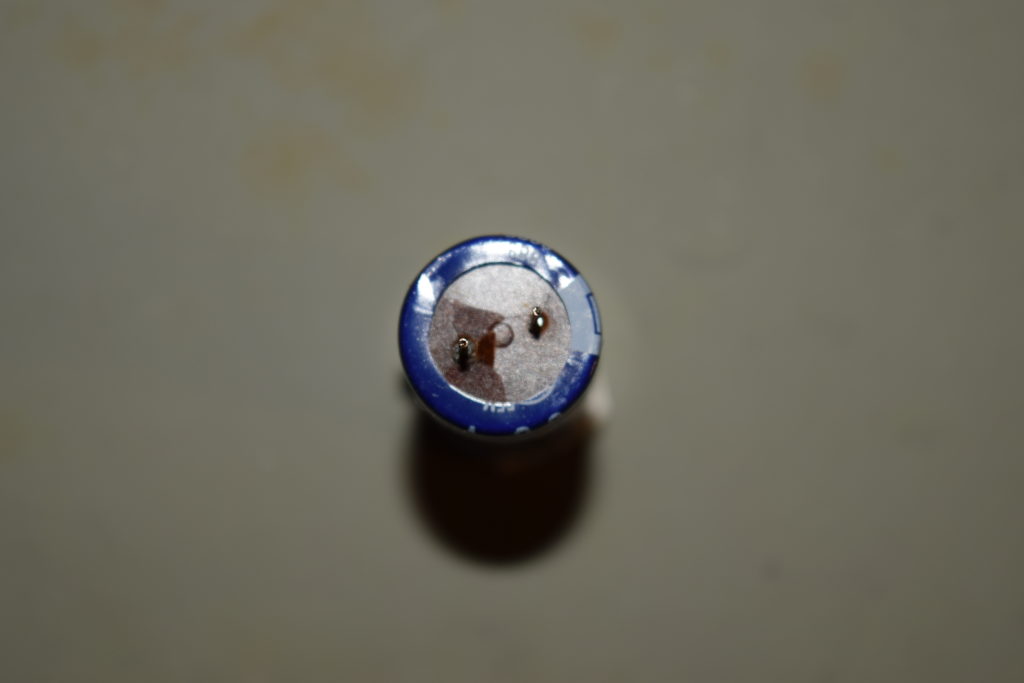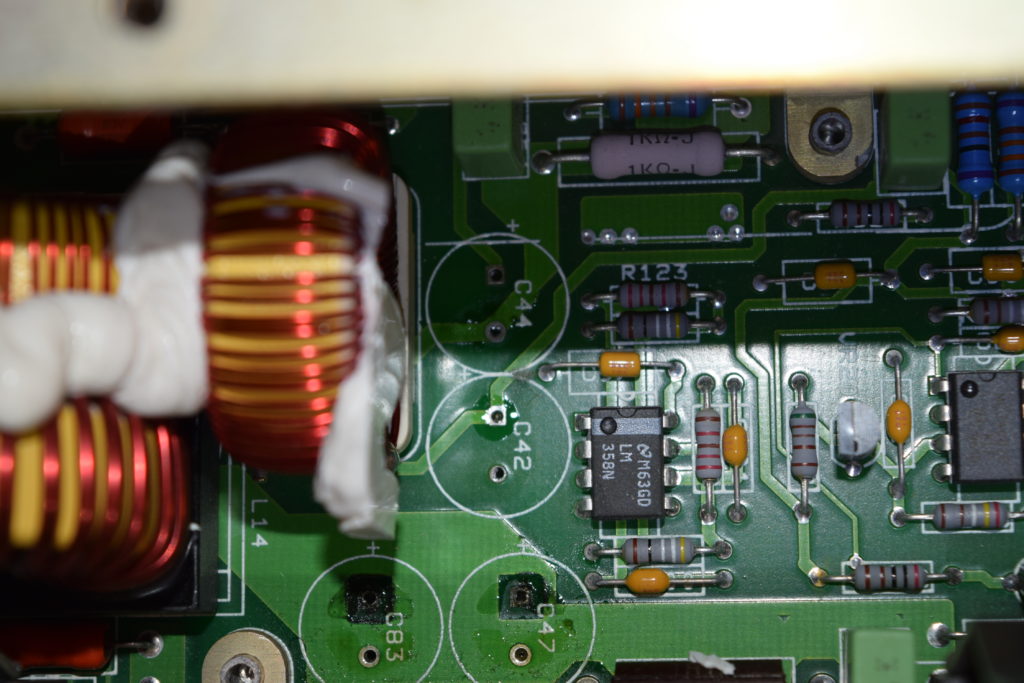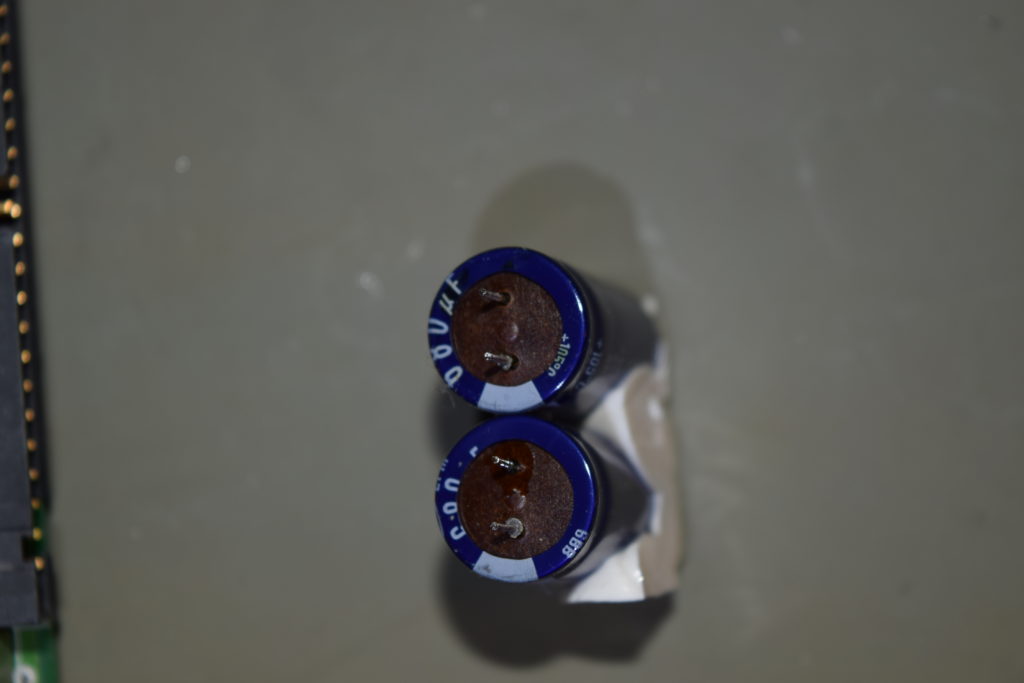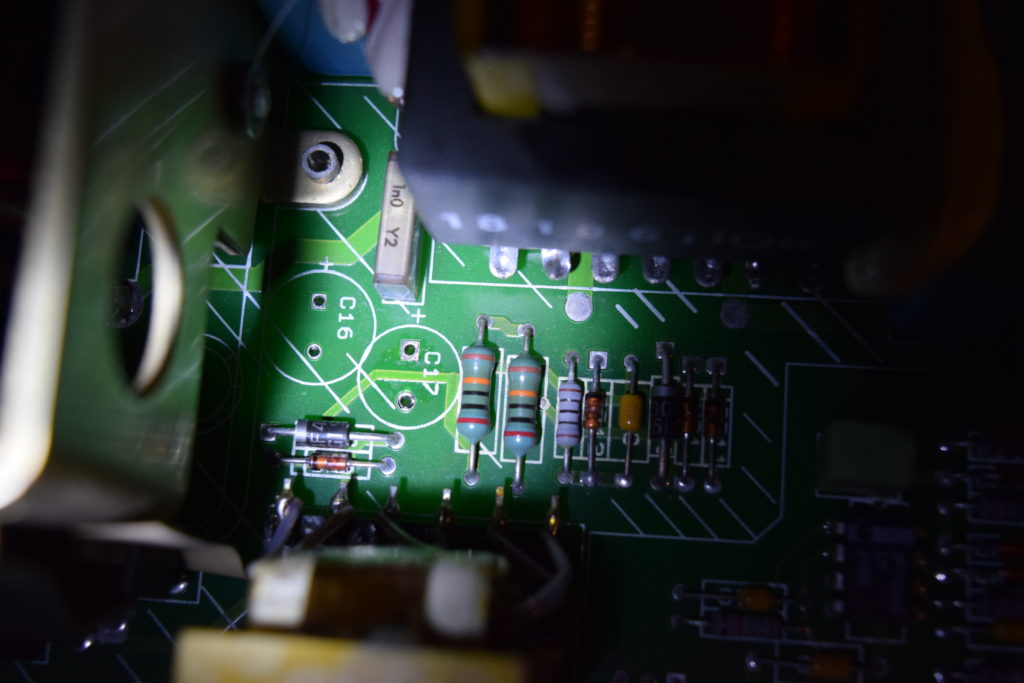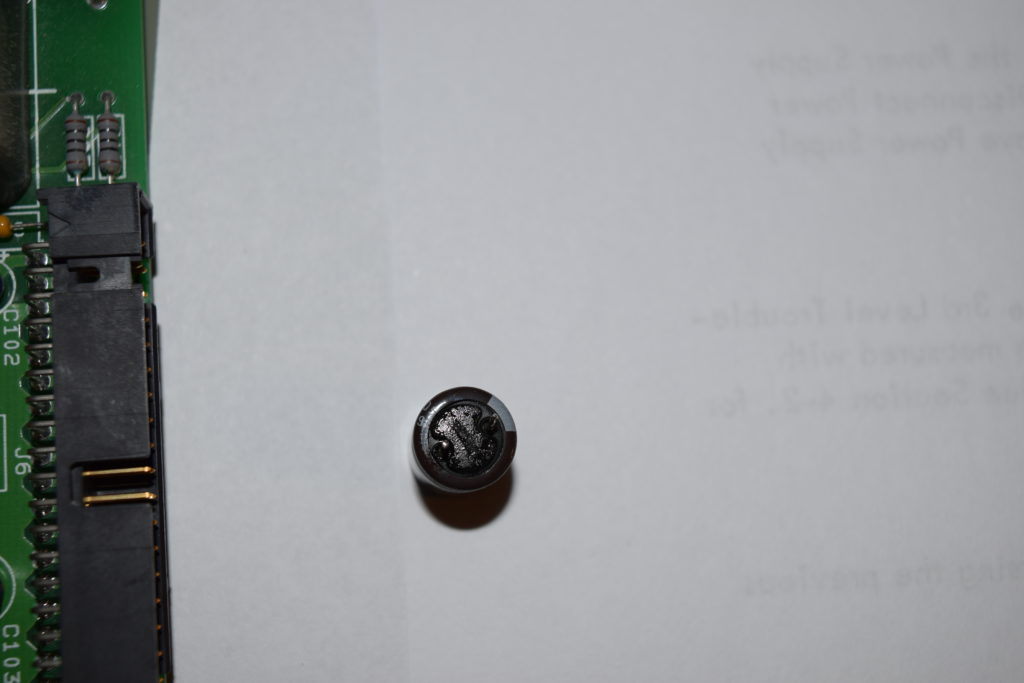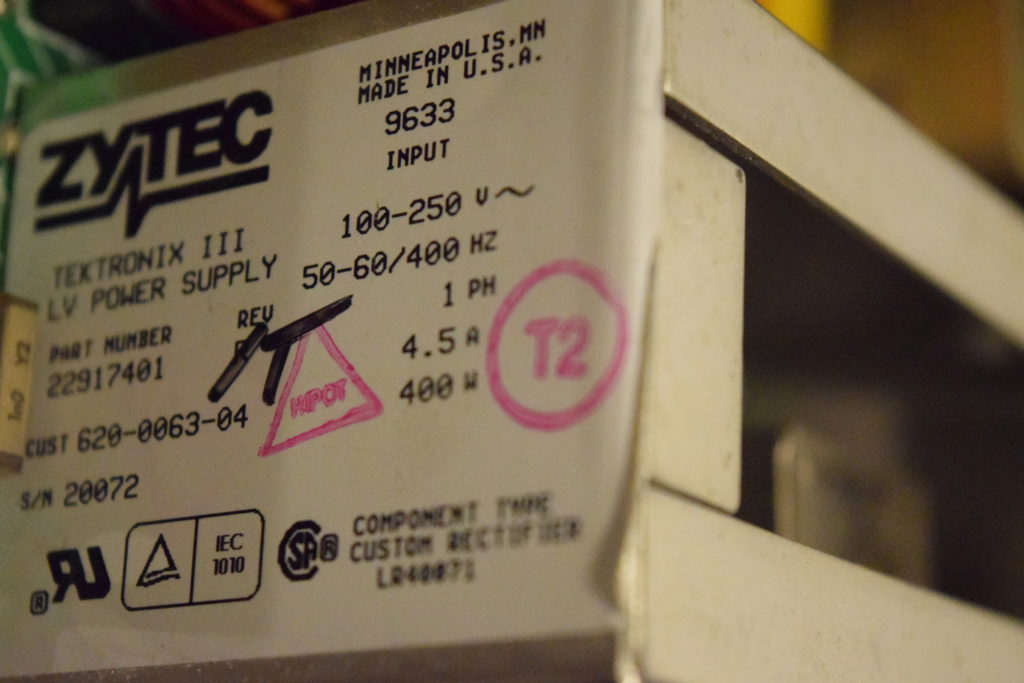While servicing a TDS 754A for a client, I smelled burnt electrolyte near the power supply section. Although it isn’t the cause of the problem yet, I know it’s a ticking time bomb.
By comparing the good power supply from my TDS 784A (same base design), I saw one of the leads of a higher power diode looks corroded (black stuff) yet the same diode on the good power supply has rainbow discoloration. It suggested that the assembly of the same part number is likely to fail by poor design (must be heating too close to the capacitor). Here’s the comparison of the C49 that caught my attention:
- TDS 754A (Bad for sure)
- TDS 784A (Slightly better. Less obvious leak)
And after removing C49 on TDS 754A, it’s clearly this capacitor has leaked and corroded one of the diode’s lead nearby:
By taking a closer look, I noticed a bit of stains around most 2700uF 10V Nichicon capacitors. Only C86 and C30 haven’t leaked yet. Might as well replace them all since there are 8 of them and 6 of them leaked.
C85 has green stuff all over it and smelled horrible. Surprisingly the ESR and capacitance is still within specs. That’s why the unit still functions. It’s just a matter of time before the power supply blows up and take out the commonly known transistors with it if I had left it there:
C47 and C48 is a mess:
C43 doesn’t look too bad, but it actually leaked. The clear fluid there is not flux, and the diode leads nearby stained for a reason:
C29 and C26 leaked as well:
- C29 C26 leak PCB
- C29 C26 leak Caps
C30 near them is clean though, the one out of two survivors:
Despite I haven’t seen leak residue on the PCB for the 680uF 35V, they are located close to high heat areas so I desoldered them to take a look. Turns out C21 cracked,
- C21
- C21 Cracked
C44 leaked a little, C42 is intact (it’s just flux):
- C44 (Top) C42 (Bottom)
- C44 (Top) C42 (Bottom)
All 680uF there are Marron capacitors.
So basically, I couldn’t trust the caps anymore and I desoldered the rest to check for leaks. Some of the Matsushita / Panasonic branded tinier capacitors far from heat sources survived. The 100uF 25V capacitor (Matsushita) at C33 near the heatsink also leaked, but it’s not too visible until I see the corroded pads after desoldering it.
I took out the last Nichicon there, a smaller 47uF 80V at C17, despite I don’t see any visible leaks before I desolder it. Glad that I did. It clearly leaked (can see it by looking at the bottom of the extracted capacitor), but not outside the capacitor’s casing’s diameter:
- C14 Leak PCB
- C14 Leak Capacitor
To avoid troubleshooting nightmare (uncommon problems) in the future, replace ALL electrolytics on the power board regardless of whether they are good or not given the majority of the capacitors leaked in this example. If you leave one or two old capacitors there and they leaked in the future, it’d be an uncommon problem that you can’t get any advice anywhere since nobody serviced the unit the same way as you did.
To be fair, Tektronix didn’t make this 400W power supply, Zytec did:
I used to think that the TDS 700 series doesn’t need much work because the SMD aluminum electrolytic capacitors on the acquisition board. But now I can see that anything that’s electrolytic leaks (CRT driver, power supplies, front-panel keypad, RS-232/Centronics board, processor board) in this TDS 500~700 series.
Nonetheless, it’s still a positive trait that there are no electrolytics on the TDS 700 series acquisition board, as it’s the most expensive and fragile piece. Acquisition board with leaked electrolytes is toasted (beyond economic repair) if you leave the electrolyte there too long.
Do NOT buy TDS 300~800 series off used market if you do not have to (like you have automation written for it or you’ve used it for 20 years and it’s all ingrained in your head) no matter how cheap they are (or SEEMINGLY working). The money is much better spent on HP 54520/54540 series if you are on a very tight budget. TDS 300~700 series don’t have much usable life left unless it’s verified new-old-stock. All fixes to TDS 300~700 problems are are laborious, frustrating and expensive.
It’s the same things that breaks for the same reason (unreliable design). That means if you simply swap modules with another used unit, or buy another identical unit, you are going to run into problems one way or the other in a short amount of time. Basically, you are only squeezing the last few puffs off a disposed cigarette butt.
I have built the knowledge and parts to rebuild these congenitally sick puppies, but as I discovered the number of common problems are still growing strong, I’m staying out of the market for it and sell whatever I have left (I’ll strengthen them before selling, of course).
If you absolutely have to rebuild a TDS 300~800 series oscilloscope and are willing to spend good money on it, which is typically the case if you:
- have an automated system written for it that you need an exact replacement
- have used the unit for 20+ years that you’d willing to pay to not painfully relearn.
- do not want to change the procedures in a bureaucratic environment
I have the parts and knowledge to extend the unit’s life that you cannot find anywhere else. It’s super involved, but I’d be willing to help if I’m the last resort.
If you choose to send me a unit for rebuild to extend its life, I’ll make it mandatory to replace electrolytics capacitors in these boards:
- Processor board
- RS-232/Centronics board (Option 2C)
- Front panel keypad
- CRT driver board
- Power supply module
- Acquisition board (if your model uses SMD aluminum electrolytics).
Acquisition board cost a lot more to recap as there’s a lot of capacitors if the model uses any.
because electrolytic capacitor failures cause symptoms that are very hard to troubleshoot (most of those are power rail capacitors, which if they fail, unstable voltages gives unpredictable erratic behavior).
The following is optional and billed separately:
- New CRT tube for color CRT screens. I have six units left so far. First come, first served.
Tuning the tube to match the CRT board is very labor intensive. - Rebuild attenuator hybrid (they are consumables)
- Troubleshoot/repair existing known symptoms
I give 3 years warranty for the repairs or preventative service I’ve carried out and it’s not user inflicted damage after the repair (like feeding high voltage to the inputs).
Call me at 949-682-8145 if you are truly need to rebuild a TDS 500~700 model and is willing to pay good money for it.
![]()
